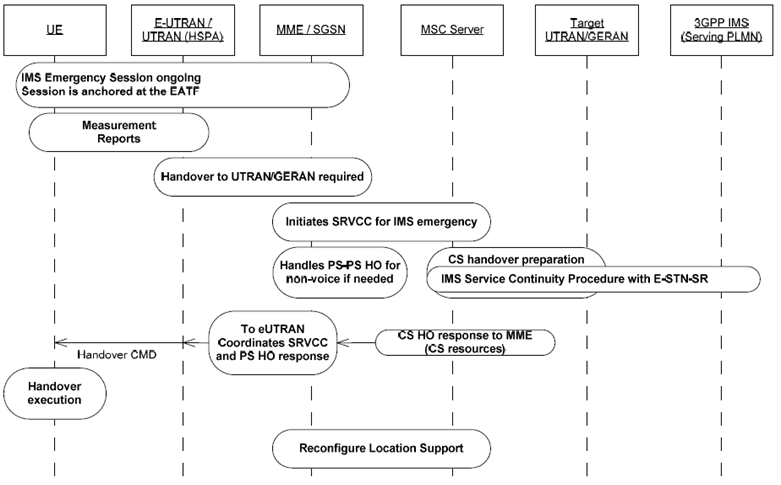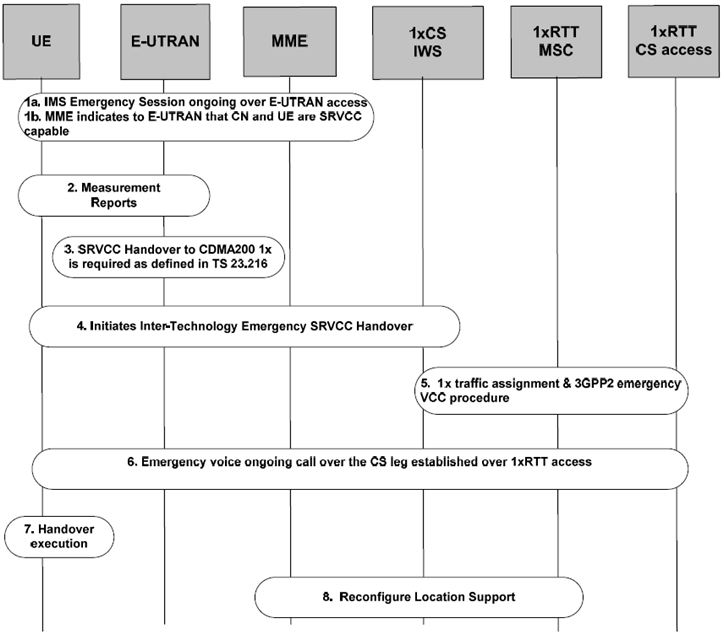Content for TS 23.216 Word version: 18.0.0
4.2.4 SRVCC for IMS emergency sessions |R9| p. 16
4.2.4.1 E-UTRAN/UTRAN (HSPA) to 3GPP UTRAN/GERAN p. 16
UE initiates the IMS emergency session as specified in TS 23.167, TS 23.401 for E-UTRAN or TS 23.060 for UTRAN (HSPA). For facilitating session transfer (SRVCC) of the IMS emergency session to the CS domain, the IMS emergency session needs to be anchored in the serving IMS (i.e., in visited PLMN when roaming) as specified in TS 23.237.
The E-UTRAN initiates the SRVCC procedure as specified for regular Voice over IMS session.
SRVCC for IMS emergency session can be supported regardless of the subscription data from the HPLMN. If the MME detects IMS emergency session event (e.g., emergency APN and associated QCI-1 bearer setup), MME shall update the E-UTRAN that SRVCC is possible by including "SRVCC operation possible" indication via S1 AP UE CONTEXT MODIFICATION REQUEST, if needed.
After IMS emergency session is released, MME shall restore the SRVCC indication to the same status as prior to the emergency session was established. If needed, reverting SRVCC indication to "not possible" is performed by including "SRVCC operation not possible" indication via S1 AP UE CONTEXT MODIFICATION REQUEST. This allows the MME to update E-UTRAN to invoke SRVCC for emergency session while the SRVCC is not allowed for normal IMS voice session due to subscription data from the HPLMN (i.e., No STN-SR and C-MSISDN received from the subscription data are not considered by the serving MME (e.g. HSS).
The MME is aware that this is an emergency session and sends an indication to the MSC Server enhanced for SRVCC. MSC Server then initiates the IMS service continuity procedure with the locally configured E-STN-SR to the serving IMS. When handover of the emergency session has been completed, the MME/SGSN or the MSC Server may initiate location continuity procedures for the UE as defined in TS 23.271.

Figure 4.2.4.1-1: Overall high level concepts for SRVCC IMS emergency session with E-STN-SR
(⇒ copy of original 3GPP image)
(⇒ copy of original 3GPP image)
4.2.4.2 E-UTRAN to 3GPP2 1xCS p. 17
The UE initiates emergency session over E-UTRAN as specified in TS 23.167, TS 23.401, upon detecting handover is required from E-UTRAN to CDMA 1x, the SRVCC emergency procedure apply. To support handover of emergency session the network is aware that the UE and core network support SRVCC and has information to identify Emergency session. When handover of the emergency session has been completed, the MME or the 1xRTT side may initiate location continuity procedures for the UE as defined in TS 23.271.

4.2.4.3 SRVCC in Limited Service Mode p. 18
4.2.4.3.1 E-UTRAN/UTRAN (HSPA) to 3GPP UTRAN/GERAN p. 18
In order to support SRVCC emergency session domain transfer for UEs in Limited Service Mode (e.g. UICC-less), the MME/SGSN shall support Limited Service Mode UE emergency attach defined in TS 23.401 and TS 23.060 using unauthenticated IMSI or equipment identifier.
When E-UTRAN/UTRAN determines that SRVCC is needed, the MME/SGSN invokes SRVCC procedures to the MSC Server including the UE's equipment identifier. The MSC Server will setup the call leg towards the EATF with the UE's equipment identifier. This procedure is defined in TS 23.237.
4.2.4.3.2 E-UTRAN to 3GPP2 1xCS p. 18
In order to support SRVCC emergency session domain transfer for UEs in Limited Service Mode (e.g. UICC-less), the MME shall support Limited Service Mode UE emergency attach defined in TS 23.401 using unauthenticated IMSI or equipment identifier.
When E-UTRAN determines that SRVCC is needed, the MME invokes SRVCC procedures to the 1xCS IWS including the UE's equipment identifier.
4.2.4.3.3 NG-RAN to 3GPP UTRAN |R16| p. 19
Access to 5GS in Limited Service Mode is specified in TS 23.501.
The AMF invokes SRVCC procedures to the MSC Server enhanced for SRVCC via the MME_SRVCC, including the UE's equipment identifier. The MSC Server will setup the call leg towards the EATF with the UE's equipment identifier. This procedure is specified in TS 23.237.
4.2.4.4 eCall over IMS |R14| p. 19
SRVCC is supported for handover of the voice channel of an eCall Over IMS from E-UTRAN/UTRAN (HSPA) to 3GPP UTRAN/GERAN. The support is exactly the same as for handover of the voice channel of an IMS emergency call from E-UTRAN/UTRAN (HSPA) to 3GPP UTRAN/GERAN with the addition of continuing support for transfer of updated MSD from the UE to an emergency centre/PSAP by in-band means.